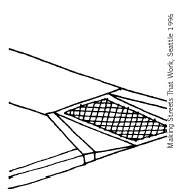3. Curb Ramps
Curb ramps (wheelchair ramps) provide access between the sidewalk and roadway for people using wheelchairs, strollers, walkers, hand carts, bicycles, and also for pedestrians with mobility problems who have trouble stepping up and down high curbs. Curb ramps must be installed at all intersections and midblock locations where pedestrian crossings exist, as mandated by Federal legislation. Wheelchair ramps must have a slope of at least 12:1 (1 inch per foot or 8.33%) and a maximum side slope of 20:1, and must be designed in accordance with the ADA guidelines.
It is required, where feasible, to build curb ramps for each crosswalk at an intersection rather than having a single ramp at a corner for both crosswalks. This provides improved directional guidance to visually impaired pedestrians. Similarly tactile warning devices can be used to alert the visually impaired of the ramp and crosswalk. All new construction or major maintenance projects are required to include curb ramps. In addition, all agencies should upgrade existing facilities. They can begin by conducting audits of their pedestrian facilities to make sure transit services, schools, public buildings and parks, etc. are accessible to pedestrians in wheelchairs.
While curb ramps are needed for use on all types of streets, priority locations are in downtown areas and on streets near transit stops, schools, residences, medical facilities, and shopping areas.


Purpose:
- Creates accessible sidewalks and walkways.
Considerations:
- Follow American with Disabilities Act (ADA) guide-lines.
Estimated cost
The cost is approximately $800 to $1,500 per curb ramp (new or retrofitted)